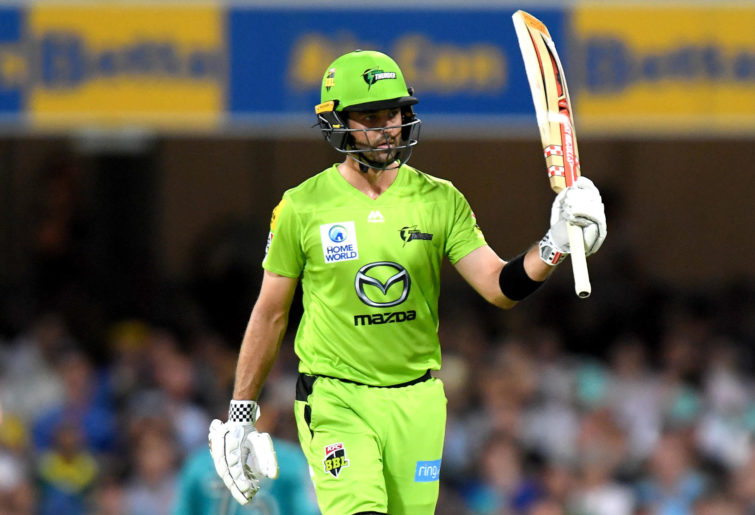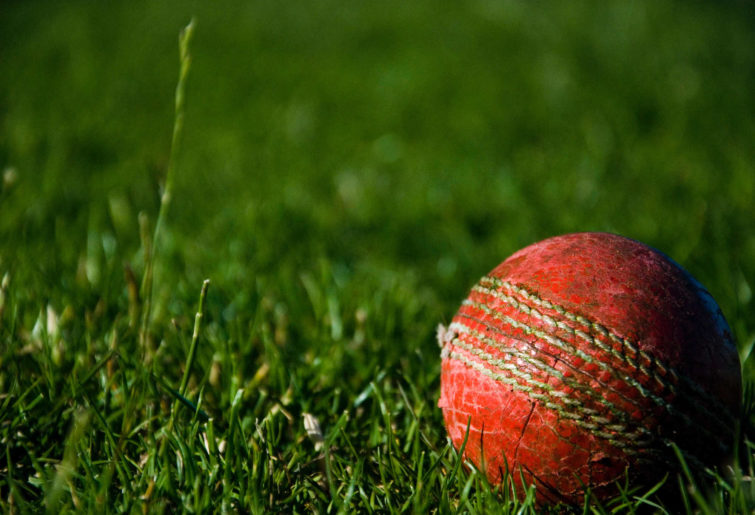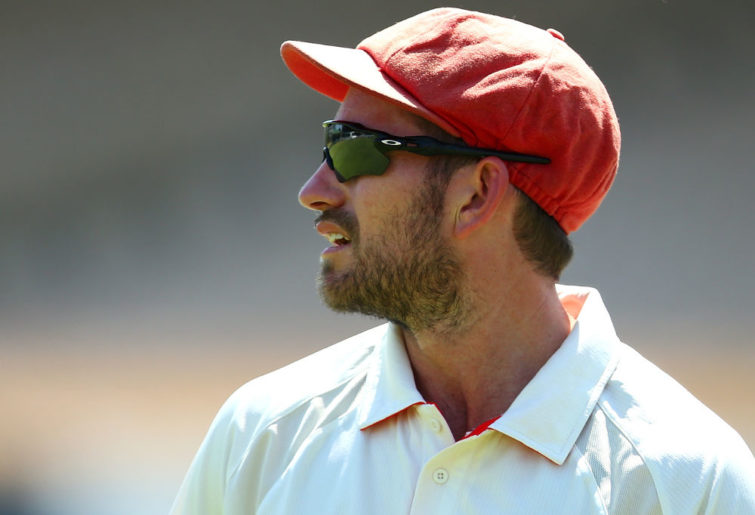This is the fifth article in a series where I select a team of cricketers from each country who have the distinction of playing in only one Test.
460 players have now worn the baggy green in Test matches since inaugural captain Dave Gregory won the toss and elected to bat in Australia’s very first Test in Melbourne in 1877.
Of that number, just over 70 players only had one opportunity on the Test arena. Here is a team, in batting order, made up of Australian players since 1970 who only played one test.
1. Paul Hibbert – Hibbert was a left hander who’s stodgy batting style earned him the ironic nickname “dasher”.
After he scored a century for Victoria in 1977 against the touring Indian side without notching up a single boundary, and in the absence of any strong competition as a result of the WSC split, he was called into the Test team for the first Test of the series against India in Brisbane.
Hibbert scored 13 off 77 balls in the first innings, this time including a boundary, and 2 off 12 balls in the second innings. Australia went on to win the game thanks primarily to the batting of Peter Toohey and Bob Simpson, while Wayne Clarke was the pick of the bowlers.
Hibbert scored nearly 4,800 runs at first class level at an average of just under 39, including nine centuries and 25 fifties.
2. Ashley Woodcock – Woodcock was a regular in the South Australian team between 1967 and 1979, and he finally got his opportunity at Test level in 1974 at the age of 27.
Playing at his home ground at the Adelaide Oval, the right hander opened the batting with Keith Stackpole in the third Test against the touring New Zealand team. He scored a steady 27 off 66 balls as Australia put on a winning score of 477 in the first innings, thanks to fine knocks by both Rod Marsh and Doug Walters.
Woodcock’s first class figures were solid without being remarkable, scoring just over 4,500 runs at an average just under 31, with only five centuries and 31 half-centuries. An unusually low conversion rate for an opening batsman.
3. Jeff Moss – Moss was a more than handy cricketer towards the end of the 70s and can consider himself unlucky just to get the one test. A left hander, who was more at home opening the batting, he was called in to the Test team at the age of 31 to replace the injured Graham Yallop in the second Test against Pakistan at the WACA in 1979.
Batting in Yallop’s position at five, Moss scored a cautious two hour 22 in the first innings, and then 38 not out in the second, as Australia comfortably won the game. He wasn’t called on again by the Australian Test selectors and finished with a Test average of 60.
In his first class career for Victoria, he scored over 3,400 runs at the excellent average of nearly 44. He also notched up nine centuries and 14 half-centuries along the way.
4. Callum Ferguson – To many, the recently-retired Ferguson was an enigma inside a puzzle. Nearly 9,400 runs in 147 first class games at an average of around 37, 20 centuries and 49 fifties, 30 ODIs, and a solitary Test match some 12 years after making his first class debut.
Ferguson was often overlooked when in pretty good form during his career, and he was given only one opportunity to show his wares at Test level when he was called into the struggling Australian team to face South Africa in the second Test in Hobart in 2016.
Batting at 6, he was run out for three in the first innings and fell to Rabada for one in the second. Joining him as a one Test debutant in that match was fellow South Australian Joe Mennie. Australia lost by an innings and 80 runs and Ferguson lost his place in the side for the next Test to Nic Maddinson.

Callum Ferguson. (Photo by Bradley Kanaris/Getty Images)
5. Stuart Law (Captain) – Just try and get your head around these numbers: 27,080 first class runs at an average of just over 50; 79 first class hundreds and 128 half-centuries; over 100 ODIs and T20s for Australia; 367 first class games; 1 (one) Test match.
How Stuart Law only ever got one Test match is a mystery to me. Yes, Australia had some good batsmen around at the time, but Law was such a success in both England and Australia that you would have thought he’d be a certainty to play more than one Test.
That big day came for Law when he was selected to play the first Test match against Sri Lanka at the WACA in 1995, a game won by an innings and more by the home team, after they put on over 600 runs in the first innings. Law finished on 54 no, but he was only keeping a spot in the batting order warm for Steve Waugh, who returned for the rest of the series.
6. James Faulkner – Faulkner was always a prodigious talent as a junior but somehow ended up playing his last international match for Australia at the age of just 27 in 2017. At one point in his career he looked odds on to become the bowling Test all-rounder that Australia needed, but it wasn’t to be, although he featured heavily in limited over cricket formats for a number of years.
He played 63 firsts class games over ten seasons, and finished with the respectable bowling figures of 192 wickets at an average of just under 25, and also scored nearly 2,600 first class runs at an average of just under 31. Nothing wrong with those numbers, and throw in Faulkner’s competitive nature and ability in the field, and he had Test match all-rounder written all over him.
His one Test chance came in the drawn dead rubber fifth Test against England at the Oval in 2013 when he scored 23 and 22 with the bat, off as many balls, and finished with match figures with the ball of 6/98, including the wickets of Ian Bell, Alastair Cook and Jonathan Trott. And that was it!

Cricket
7. Phil Emery (wicketkeeper) – Emery was a very good keeper who had the misfortune of appearing on the first class scene at the same time as Ian Healy. His first class career for NSW was quite impressive, over 380 dismissals behind the stumps, and nearly 3,300 runs at an average of just over 26, with just one century and 17 half centuries.
His sole Test match came in the third Test against Pakistan and Lahore in 1994, when he deputised for the injured Ian Healy. Batting as night watchman in Australia’s first innings, her retired hurt on 8 no, but recovered well enough to take five dismissals in Pakistan’s second innings.
8. Beau Casson – Casson was a left arm wrist spinner and right hand bat who had some claims as an all-rounder. Health issues saw him retire from first class cricket at the age of just 29, leaving a batting average of just over 22 with eight fifties, and 123 first class wickets at an average of over 43.
After some strong performances for NSW, particularly on the spin friendly SCG, he was selected in the Australian side for the 2008 West Indian tour as a back up to Stuart MacGill.
MacGill retired after the second Test in Antigua presenting Casson with his opportunity in the third Test at Bridgetown. Casson scored 10 in Australia’s first innings, went wicketless in seven expensive overs in the West Indies first innings, and then took three wickets when the West Indies batted a second time. He was out of favour with the selectors by the time the Australian side embarked on their tour to India later that year.
9. Joe Mennie – Recently retired, Mennie was an accurate right arm medium-fast bowler who was one of the best in the game during his ten year first class career, as attested by his 297 wickets at an average just over 26. He was also pretty handy with the bat, notching up over 1,900 runs at an average just over 17, with eight fifties.
His Test opportunity came in the second Test against South Africa in 2016, when he was called in to the team to replace the injured Peter Siddle. South Africa cruised to victory by an innings and 80 runs, and Mennie’s only success with the ball came in the first innings when he took 1-85 off 28 overs.
Both he and fellow debutant, Callum Ferguson, exited the side after this match never to return.
10. Chad Sayers – Sayers’ right arm swing bowling was, at times, unplayable, and he was one of the most successful Shield bowlers during his career. First class figures of 320 wickets at 26.51 tell the story, and he took five wickets in an innings on 16 occasions and 10 wickets in a match three times. He was also a useful late order batsman, scoring nearly 1,600 runs at an average just over 15.
Always on the fringe of national selection, he finally made his Test debut at the age of 30 in the fourth Test against South Africa in Johannesburg in 2018, a match won by the home side by nearly 500 runs. He finished with the figures of 2-78 off 35 overs in South Africa’s first innings, including the prized wicket of AB de Villiers, and went wicketless in South Africa’s second innings.
From a batting perspective, he finished with a pair. Injuries later that year saw him fall out of contention for a Test recall and he retired this year.

Chadd Sayers of South Australia looks on while fielding during day one of the Sheffield Shield match between Western Australia and South Australia at WACA on November 13, 2017 in Perth, Australia. (Photo by Paul Kane/Getty Images)
11. Mick Malone – Mick Malone probably only has himself to blame for playing just one Test match. Australia were down 3-0 in the 1977 Ashes series when the selectors gave Malone his first Test opportunity in the fifth Test at the Oval. The big right arm seamer grabbed his opportunity with both hands taking 5-63 off 47 overs, dismissing the England side for 214 in the first innings.
Batting at 10, he then scored 46 runs, and followed that up by taking 1-14 off 10 overs in England’s second innings, before the rain interrupted match ended in a draw. In what was probably a man of the match performance, he finished with a Test batting average of 46, and six wickets at an average of just under 13. If he wasn’t one of the many Australians who had just signed on to play WSC, he may have played many more Test matches.
12. John Hastings – A right arm fast bowling all-rounder, Hastings played 75 first class games, 38 limited overs games for Australia and just the one test. He claimed 239 first class wickets at an average of just over 27, and notched up over 2,200 runs at an average of just over 22, including 11 half centuries. Big and aggressive, Hastings certainly looked the part, but lacked the bowling penetration for the step up to Test cricket.
His only Test match came in 2012 in the third Test against South Africa in Perth, a game easily won by the visitors. Hastings opened the bowling in the first innings and took the wicket of AB de Villiers, finishing with the figures of 1-51 off 20 overs.
Bowling second change in South Africa’s second innings, he went wicketless for 102 runs off just 19 overs. He fared better with the bat, though, scoring 32 and 20.
How good is the team?
The top order, with the exception of Callum Ferguson, don’t exactly inspire a lot of confidence, with Hibbert, Woodcock and Moss having only 23 first class centuries between them. A lot would depend on both Ferguson and Law to produce the runs, with the help of Faulkner and Emery, and perhaps some contributions from the bowlers who have some claims with the bat. From a bowling perspective, the side lacks both a front line spinner and an express pace spearhead, but in the right conditions, Mennie, Malone and Sayers would pose some problems for all but the best batsmen, and Faulkner wouldn’t die wondering with the ball in his hands.































































































